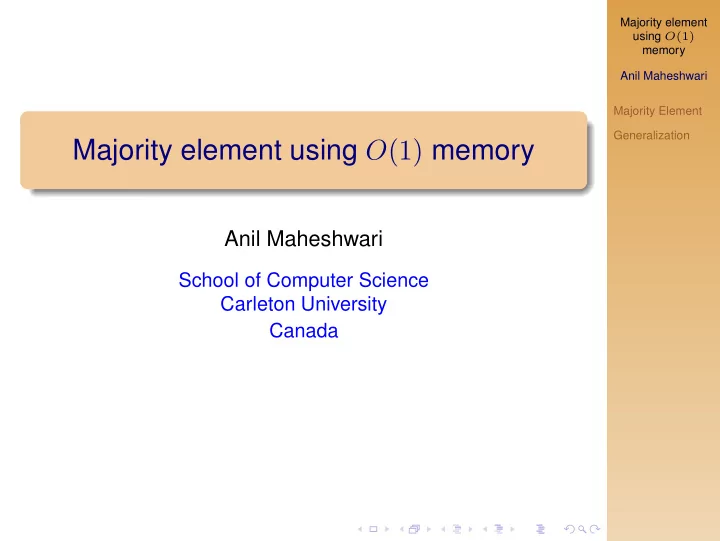

Majority element using O (1) memory Anil Maheshwari Majority Element Generalization Majority element using O (1) memory Anil Maheshwari School of Computer Science Carleton University Canada
Outline Majority element using O (1) memory Anil Maheshwari Majority Element Generalization Majority Element 1 Generalization 2
Problem Majority element using O (1) memory Anil Maheshwari Majority Element Finding the Majority Element Generalization Input: A stream consisting of n elements and it is given that it has a majority element, i.e. occurs at least 1 + ⌊ n 2 ⌋ times a . Output: The majority element. a ***Video Recorded version says ⌈ n 2 ⌉ and that is incorrect*** An Example: n = 19 Input Stream = [3 2 4 7 2 2 3 2 2 1 4 2 2 2 1 1 2 3 2]
1st Attempt Majority element using O (1) memory Anil Maheshwari Majority Element Finding the Majority Element Generalization Input: A stream consisting of n elements and it is given that it has a majority element. Output: The majority element. Solution 1: Store the stream in an array A . Sort and pick the middle element (if elements can be ordered). Input: 3 2 4 7 2 2 3 2 2 1 4 2 2 2 1 1 2 3 2 Sorted: 1 1 1 2 2 2 2 2 2 2 2 2 2 3 3 3 4 4 7
2nd Attempt Majority element using O (1) memory Anil Maheshwari Majority Element Finding the Majority Element Generalization Input: A stream consisting of n elements and it is given that it has a majority element. Output: The majority element. Solution 2: Count frequency of each element. Input: 3 2 4 7 2 2 3 2 2 1 4 2 2 2 1 1 2 3 2 Element 1 2 3 4 7 Frequency 3 10 3 2 1
Do we need that much space? Majority element using O (1) memory Anil Maheshwari Majority Element Generalization Finding the Majority Element Input: A stream consisting of n elements and it is given that it has a majority element. Output: The majority element. Memory required in Solutions 1 & 2 ≥ Number of distinct elements in the stream. What if we can only use O (1) space?
Majority Algorithm Majority element using O (1) memory Input: Array A of size n consisting a majority element Anil Maheshwari Output: The majority element Majority Element 1 c ← 0 Generalization 2 for i = 1 to n do if c = 0 then 3 current ← A [ i ] ; c ← c + 1 4 end 5 else 6 if A [ i ] = current then 7 c ← c + 1 8 end 9 else 10 c ← c − 1 11 end 12 end 13 14 end 15 return current
An Illustration Majority element using O (1) memory Anil Maheshwari A [ i ] 3 2 4 7 2 2 3 2 . . . Majority Element current . . . Generalization c 0 . . . for i = 1 to n do if c = 0 then current ← A [ i ] ; c ← c + 1 end else if A [ i ] = current then c ← c + 1 end else c ← c − 1 end end end return current
Analysis of Majority Algorithm Majority element using O (1) memory Anil Maheshwari Majority Element Generalization Observations Algorithm maintains only two variables: c and 1 current. Correctness: Each non-majority element can ‘kill’ at 2 most one majority element. Claim By performing a single pass, using only O (1) additional space, we can report the majority element of A (if it exists).
2nd Problem Majority element using O (1) memory Anil Maheshwari Majority Element Generalization Generalization For a data stream A , using very little space, we are interested to report All the elements that occur at least n/ 4 times. 1 All the elements that occur at least n/k times for 2 some constant k , i.e. report all heavy-hitters .
Misra & Gries Algorithm Majority element using O (1) memory Anil Maheshwari Majority Element Input: A stream consisting of n elements and an integer Generalization constant k < n . Output: All the elements that occur at least n/k times. Initialize k bins, each with null element and a counter 1 with 0. For each element x in the stream do 2 if x ∈ Bin b then increment bin b ’s counter elseif find a bin whose counter is 0 and Assign x to this bin Assign 1 to its counter else decrement the counter of every bin. Output elements in the bins. 3
Misra & Gries Algorithm Majority element using O (1) memory Anil Maheshwari Majority Element Claim Generalization Let f ∗ x = Frequency of x in the stream. Each heavy hitter x is in one of the bins with counter value ≥ f ∗ x − n/k . Proof. Homework! Reference: J. Misra and D. Gries,“Finding repeated elements” in Science of Computer Programming, Vol. 2 (2): 143 -152, 1982.
Recommend
More recommend